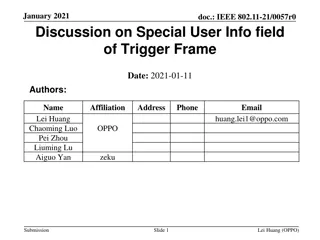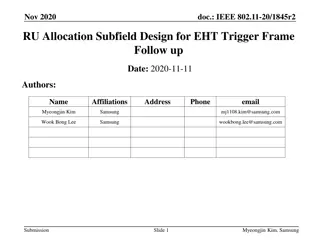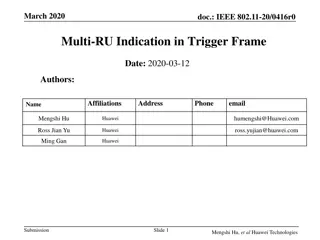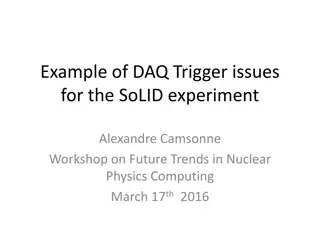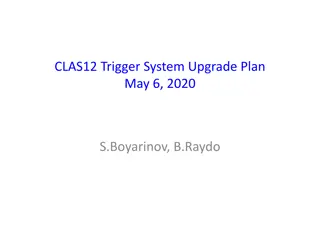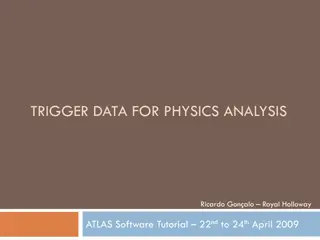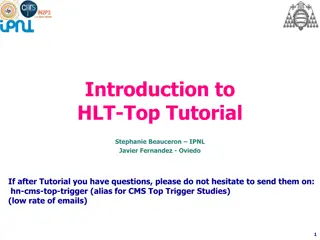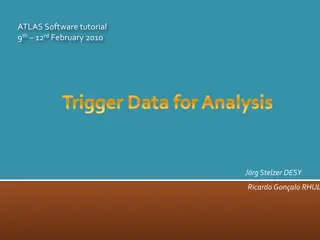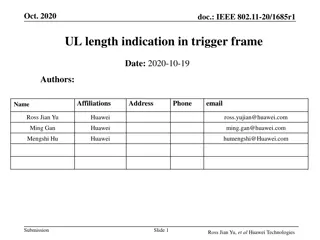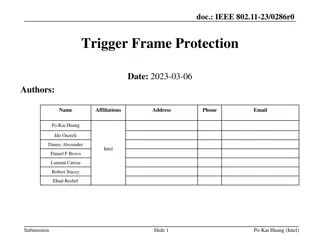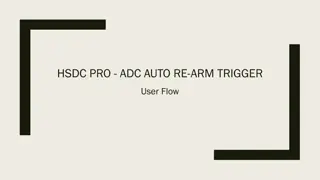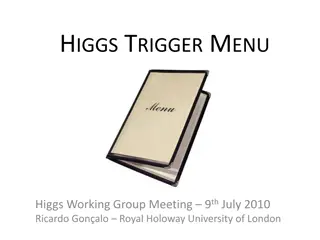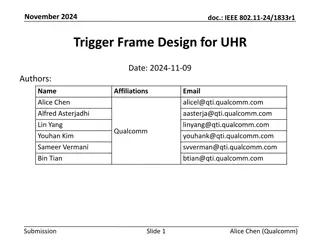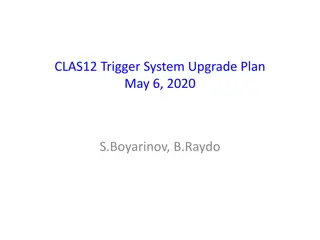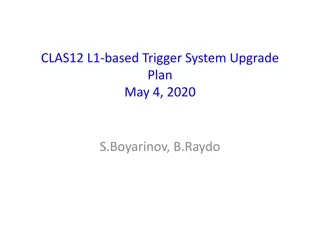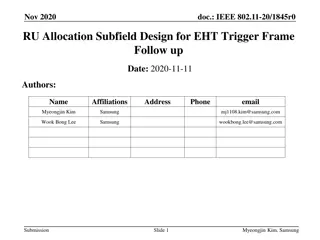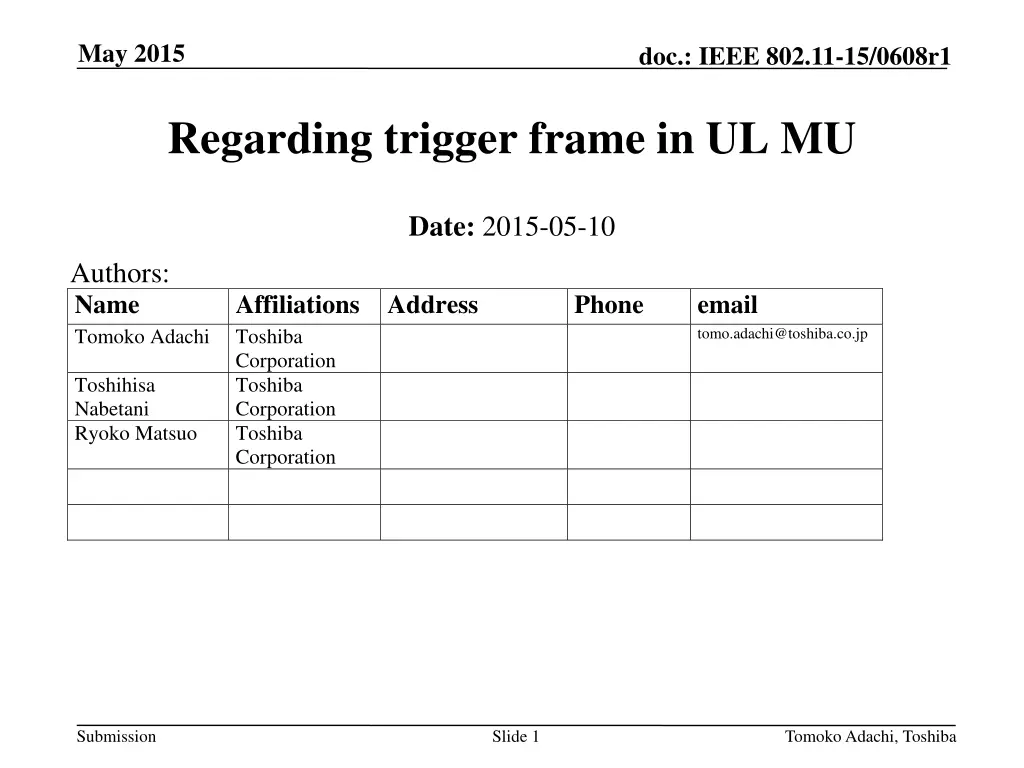
Trigger Frame in UL MU for IEEE 802.11-15
Discover the specifics of trigger frames for UL MU in IEEE 802.11-15 and the importance of collecting information at an Access Point. Explore the methods proposed to efficiently gather STAs' transmission demands, enhancing network resource utilization.
Download Presentation

Please find below an Image/Link to download the presentation.
The content on the website is provided AS IS for your information and personal use only. It may not be sold, licensed, or shared on other websites without obtaining consent from the author. If you encounter any issues during the download, it is possible that the publisher has removed the file from their server.
You are allowed to download the files provided on this website for personal or commercial use, subject to the condition that they are used lawfully. All files are the property of their respective owners.
The content on the website is provided AS IS for your information and personal use only. It may not be sold, licensed, or shared on other websites without obtaining consent from the author.
E N D
Presentation Transcript
May 2015 doc.: IEEE 802.11-15/0608r1 Regarding trigger frame in UL MU Date: 2015-05-10 Authors: Name Tomoko Adachi Affiliations Address Toshiba Corporation Toshiba Corporation Toshiba Corporation Phone email tomo.adachi@toshiba.co.jp Toshihisa Nabetani Ryoko Matsuo Submission Slide 1 Tomoko Adachi, Toshiba
May 2015 doc.: IEEE 802.11-15/0608r1 Abstract This presentation questions what kind of info should be specified in the trigger frame for UL MU and what kind of info should be collected ahead at an AP. It was considered that one of the useful info to be collected should be on STAs TX demands, and to collect this, a passive way at the AP was proposed. Submission Slide 2 Tomoko Adachi, Toshiba
May 2015 doc.: IEEE 802.11-15/0608r1 A trigger frame for UL MU On March, TGax approved to add the following to SFD [1]: x.y.z The spec shall define the following mode of operation: An UL MU PPDU (MU-MIMO or OFDMA) is sent as an immediate response (IFS TBD) to a Trigger frame (format TBD) sent by the AP. But for an AP to send such a trigger frame, it needs to collect information in advance. Information depends on what will be specified in the trigger frame. Not to waste resource, at least it is better for the AP to figure out which STAs have TX data. Submission Slide 3 Tomoko Adachi, Toshiba
May 2015 doc.: IEEE 802.11-15/0608r1 Recalling initial phase methods in [2] It was shown in [2] that asking STAs one by one to find out their TX demands gives large overhead and a need of a more rough way to grasp or estimate STAs TX demands was suggested. Submission Slide 4 Tomoko Adachi, Toshiba
May 2015 doc.: IEEE 802.11-15/0608r1 Approach to gathering TX demands Even if an inquiring sequence is immediately before the trigger frame, lifetime may expire for some of the frames and it cannot be always accurate. Then a rough estimate may be useful. AP multi-STA BA/ACK trigger Inquiry Inquiry Inquiry Inquiry lifetime expires STA 1 Resp. (YES!) NO UL MU STA 2 Resp. (YES!) STA 3 Resp. (YES!) STA 4 Resp. (YES!) Submission Slide 5 Tomoko Adachi, Toshiba
May 2015 doc.: IEEE 802.11-15/0608r1 When a STA has data to transmit It will try to access the medium by itself, anyway. If the STA is able to transmit a frame, the frame can be used to notify the AP of other remaining data in its queues. STA-oriented notification The idea is something similar to the use of a More Data field. Submission Slide 6 Tomoko Adachi, Toshiba
May 2015 doc.: IEEE 802.11-15/0608r1 Outline of STA-oriented notification STA 1 to AP STA 3 to AP Data BA/ACK Data BA/ACK same from STA 4 and 6 data data notification of remaining data in MAC header notification of remaining data in MAC header collected by AP AP recognizes STAs 1, 3, 4, and 6 have MSDUs to transmit* * may also need to consider group IDs for selecting STAs AP sends the trigger frame to STAs 1, 3, 4, and 6 Submission Slide 7 Tomoko Adachi, Toshiba
May 2015 doc.: IEEE 802.11-15/0608r1 More Data field level enough? The More Data field is only 1 bit length. If the proposed field is just the same with the More Data field, then notification will be limited very simple. 1: Yes, I have remaining data. 0: No, I don t have remaining data. If there are other kinds of information needed to be collected to generate the trigger frame, the concept may be extended to collect those, too. Submission Slide 8 Tomoko Adachi, Toshiba
May 2015 doc.: IEEE 802.11-15/0608r1 What should be specified in trigger frame? Parameters on target STAs (partial MAC Address? AID? Group ID?) resource allocation (in space/frequency) PPDU duration? (maximum?) To be able to specify PPDU duration at the AP, the AP may want parameters such as amount of buffered data from STAs beforehand. access category? 802.11ac has a loose restriction ( primary AC ) for DL-MU-MIMO. Submission Slide 9 Tomoko Adachi, Toshiba
May 2015 doc.: IEEE 802.11-15/0608r1 Summary The trigger frame should specify necessary info to have STAs start UL MU TX. AP needs to collect info to generate such specifying info, so the specifying info in the trigger frame was questioned. Info on STAs TX demands is suggested to be at least one of those collected and STA-oriented way of notification was considered. TX demand shown in a field something like a More Data field. Submission Slide 10 Tomoko Adachi, Toshiba
May 2015 doc.: IEEE 802.11-15/0608r1 References [1] 802.11-15/0365r0 UL MU procedure for 11ax system [2] 802.11-15/0064r1 Consideration on UL-MU overheads Submission Slide 11 Tomoko Adachi, Toshiba
May 2015 doc.: IEEE 802.11-15/0608r1 Straw Poll 1 What kind of information should be specified in a trigger frame? target STAs (TBD, could be MAC address/AID/Group ID) Y:N:A= (no objections) Submission Slide 12 Tomoko Adachi, Toshiba
May 2015 doc.: IEEE 802.11-15/0608r1 Straw Poll 2 What kind of information should be specified in a trigger frame? resource allocation per STA (also vote yes if you think it will be addressed by Group ID) Y:N:A= (no objections) Submission Slide 13 Tomoko Adachi, Toshiba
May 2015 doc.: IEEE 802.11-15/0608r1 Straw Poll 3 What kind of information should be specified in a trigger frame? PPDU duration (TBD, may be exact or maximum) Y:N:A= (no objections) Submission Slide 14 Tomoko Adachi, Toshiba
May 2015 doc.: IEEE 802.11-15/0608r1 Straw Poll 4 What kind of information should be specified in a trigger frame? access category Y:N:A=5:17:many Submission Slide 15 Tomoko Adachi, Toshiba
May 2015 doc.: IEEE 802.11-15/0608r1 Straw Poll 5 For an AP to send the trigger frame for UL MU TX, do you think it is useful if a STA is able to notify the AP of its TX demand by a field something like a More Data field in a frame sent from its side? Y:N:A= (no objections) Submission Slide 16 Tomoko Adachi, Toshiba

